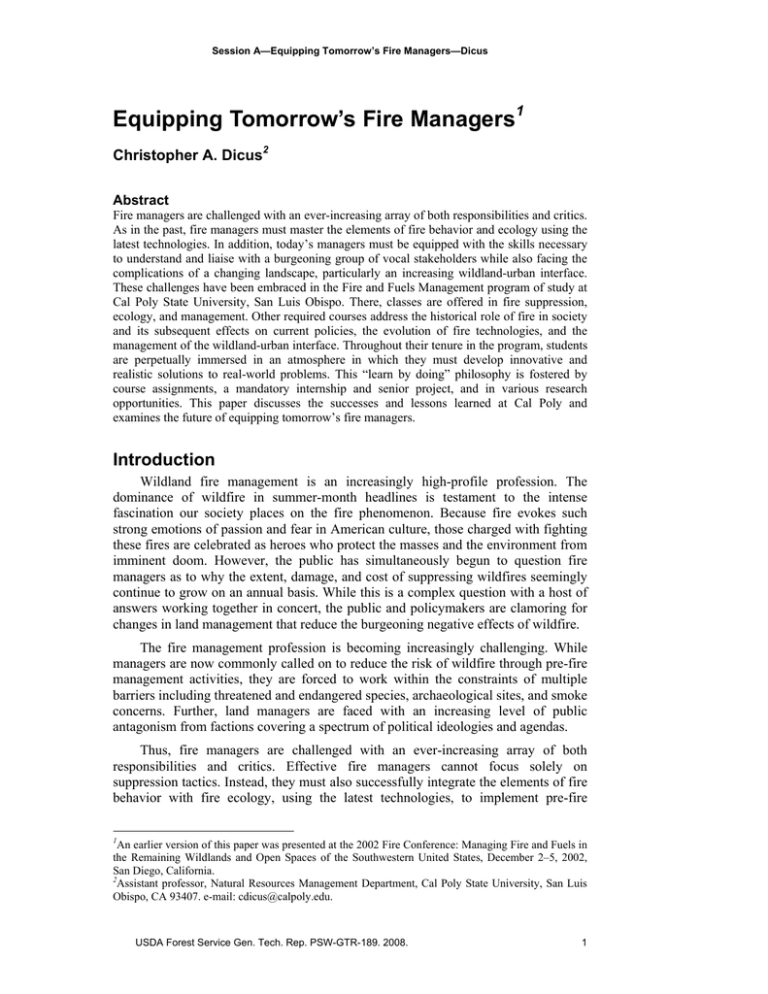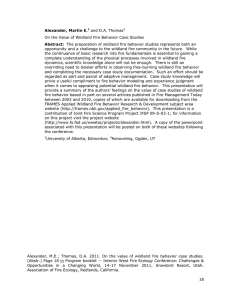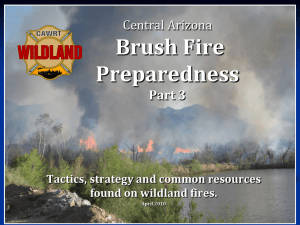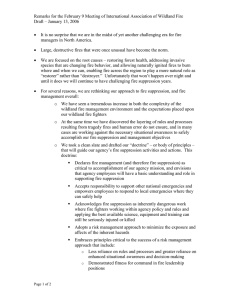Equipping Tomorrow’s Fire Managers Christopher A. Dicus 1
advertisement

Session A—Equipping Tomorrow’s Fire Managers—Dicus Equipping Tomorrow’s Fire Managers1 Christopher A. Dicus2 Abstract Fire managers are challenged with an ever-increasing array of both responsibilities and critics. As in the past, fire managers must master the elements of fire behavior and ecology using the latest technologies. In addition, today’s managers must be equipped with the skills necessary to understand and liaise with a burgeoning group of vocal stakeholders while also facing the complications of a changing landscape, particularly an increasing wildland-urban interface. These challenges have been embraced in the Fire and Fuels Management program of study at Cal Poly State University, San Luis Obispo. There, classes are offered in fire suppression, ecology, and management. Other required courses address the historical role of fire in society and its subsequent effects on current policies, the evolution of fire technologies, and the management of the wildland-urban interface. Throughout their tenure in the program, students are perpetually immersed in an atmosphere in which they must develop innovative and realistic solutions to real-world problems. This “learn by doing” philosophy is fostered by course assignments, a mandatory internship and senior project, and in various research opportunities. This paper discusses the successes and lessons learned at Cal Poly and examines the future of equipping tomorrow’s fire managers. Introduction Wildland fire management is an increasingly high-profile profession. The dominance of wildfire in summer-month headlines is testament to the intense fascination our society places on the fire phenomenon. Because fire evokes such strong emotions of passion and fear in American culture, those charged with fighting these fires are celebrated as heroes who protect the masses and the environment from imminent doom. However, the public has simultaneously begun to question fire managers as to why the extent, damage, and cost of suppressing wildfires seemingly continue to grow on an annual basis. While this is a complex question with a host of answers working together in concert, the public and policymakers are clamoring for changes in land management that reduce the burgeoning negative effects of wildfire. The fire management profession is becoming increasingly challenging. While managers are now commonly called on to reduce the risk of wildfire through pre-fire management activities, they are forced to work within the constraints of multiple barriers including threatened and endangered species, archaeological sites, and smoke concerns. Further, land managers are faced with an increasing level of public antagonism from factions covering a spectrum of political ideologies and agendas. Thus, fire managers are challenged with an ever-increasing array of both responsibilities and critics. Effective fire managers cannot focus solely on suppression tactics. Instead, they must also successfully integrate the elements of fire behavior with fire ecology, using the latest technologies, to implement pre-fire 1 An earlier version of this paper was presented at the 2002 Fire Conference: Managing Fire and Fuels in the Remaining Wildlands and Open Spaces of the Southwestern United States, December 2–5, 2002, San Diego, California. 2 Assistant professor, Natural Resources Management Department, Cal Poly State University, San Luis Obispo, CA 93407. e-mail: cdicus@calpoly.edu. USDA Forest Service Gen. Tech. Rep. PSW-GTR-189. 2008. 1 Session A—Equipping Tomorrow’s Fire Managers—Dicus treatments. In addition, they must be equipped with the skills necessary to understand and liaise with a burgeoning group of vocal stakeholders while also facing the complications of a changing landscape, particularly an increasing wildland-urban interface. Unfortunately, a formal education in fire and fuels management is somewhat rare at present. Several exemplary graduate programs that emphasize wildland fire exist today, but many are concerned primarily with specific ecological problems and graduates are not necessarily educated in management techniques and solutions. Also, these programs can only provide a limited number of graduates in a field that desperately needs qualified fire managers. Even fewer educational opportunities to adequately equip undergraduate students in fire and fuels management exist. The complex challenges of fire management have been embraced in the undergraduate Wildland Fire & Fuels Management concentration in the Forestry & Natural Resources (FNR) major at Cal Poly State University, San Luis Obispo. Throughout their tenure in the program, students are perpetually immersed in an atmosphere in which they must provide innovative and realistic solutions to realworld problems. This “learn by doing” philosophy is fostered in six courses dedicated to various aspects of fire management, mandatory internships and senior projects, and in various research opportunities. The manuscript describes the evolution of the Wildland Fire and Fuels Management concentration at Cal Poly, discusses the skills needed by today’s fire managers and how they are addressed in the curriculum, and examines the future needs at equipping tomorrow’s fire managers. Brief History of Program Dr. Tim Plumb arrived at Cal Poly in 1981 and was the earliest faculty member with an interest in wildland fire in the Natural Resources Management major. His position emphasized the management of chaparral and oak woodlands, but the pervasiveness of fire in these ecosystems naturally led him to explore fire extensively in his courses and research. Partially as a result of increasing student interest in fire ecology, the Natural Resources Management Department created the Watershed, Chaparral, and Fire Management concentration of the Natural Resources Management major in 1986. Initially, this concentration emphasized chaparral management, but student interest began to diverge into separate fire and watershed factions. In 1993, the Natural Resources Management major was replaced by the Forestry and Natural Resources (FNR) major, which was accredited by the Society of American Foresters. The Watershed, Chaparral, and Fire Management concentration remained within the new major. After Dr. Plumb’s retirement in 1997, the faculty at Cal Poly recognized the continually increasing student interest in wildland fire and hired Dr. Scott Stephens based, in part, on his extensive background in fire ecology and management. Dr. Stephens remained at Cal Poly for two years until he returned to his alma mater, U.C. Berkeley, to assume the faculty position in fire management there. In 2000, the existing Watershed, Chaparral, and Fire Management concentration was divided into the Wildland Fire and Fuels Management concentration and the Watershed Hydrology concentration, both of which are in place today. Student demand for the new fire concentration was immediate and immense, and continues to 2 USDA Forest Service Gen. Tech. Rep. PSW-GTR-189. 2008. Session A—Equipping Tomorrow’s Fire Managers—Dicus grow at a fierce rate. Dr. Chris Dicus, with a background in fire ecology and silviculture, arrived at Cal Poly in 2001 to head the new concentration and presently remains in that capacity. Curriculum The curriculum of the Wildland Fire & Fuels Management concentration goes far to equip students with the skills needed for effective fire management. Due to today’s need for successful pre-fire management, it is critical that wildland fire managers be strongly grounded in forestry and vegetation management. Thus, the success of graduates in the program is based partly on the concentration being imbedded within the Forestry and Natural Resources major, which emphasizes an ecosystem-level approach to resource management. In addition to a mandatory internship and senior project, all fire and fuels management students must successfully complete courses in fire control, fire ecology, fire management, and wildland-urban interface fire management (table 1). Restrictive electives in the concentration can be fulfilled by such courses as Fire and Society, Technology of Wildland Fire Management, an Emergency Medical Technician course, or other advisor-approved courses. Table 1—Required courses for Wildland Fire and Fuels Management concentration within the Forestry and Natural Resources major at Cal Poly State University, San Luis Obispo. Course number FNR 204 FNR 307 FNR 339 FNR 340 FNR 412 FNR 455 Restrictive electives2 Course title Wildland Fire Control Fire Ecology Internship Wildland Fire Management Senior Project Wildland-Urban Interface Fire Protection Units1 3 3 6 3 4 3 10 1 Total of 192 units to graduate in FNR major, 92 of which are Major courses May include Fire & Society, Technology of Wildland Fire Management, college-level EMT course, or other advisor-approved courses 2 At a minimum, fire managers must be equipped with an understanding of suppression concepts. Thus, students begin their concentration courses in Wildland Fire Control (FNR 204), which initiates them into basic skills and tactics needed in fire suppression. Students learn basic fire concepts such as combustion physics and fire behavior as it is affected by fuel, topography, and weather, and then proceed to suppression tactics, safety, incident command, and mechanized equipment. Laboratory exercises demonstrate concepts learned in the classroom in a field setting and allow students to “get their hands dirty.” Because the course successfully fulfills requirements of the Basic-32 federal Firefighter Training course (I-100: Introduction to the Incident Command System, S-110: Wildland Fire Suppression Orientation, S130: Firefighter Basic Training, and S-190: Introduction to Wildland Fire Behavior), it is immensely popular with majors throughout the University and has been used as a useful recruiting tool for the major and concentration. In an effort to best serve students, additional requirements to the class that would fulfill the California USDA Forest Service Gen. Tech. Rep. PSW-GTR-189. 2008. 3 Session A—Equipping Tomorrow’s Fire Managers—Dicus Department of Forestry and Fire Protection’s (CDF) 80-hour Firefighter certification are currently being explored. Fire managers must be equipped with an understanding of how fire, or its absence, will affect various ecosystems. Because of the pervasiveness of fire in the western United States and the course’s applicability to all concentrations in forestry, all students in the FNR major are required to complete Fire Ecology (FNR 307). This course investigates how fire affects vegetation, soil, water, air, fauna, and other ecosystem components as well as how it interacts with other disturbance types. Field laboratories reinforce concepts learned in the classroom and explore such topics as fuel loading and potential effects on fire behavior, dendrochronology, soil hydrophobicity, effects on wildlife, and others. Fire managers should be equipped with advanced knowledge of fire behavior and be able to utilize the latest technologies available. Students learn these and other skills in another required concentration course, Wildland Fire Management (FNR 340). There, students explore factors that affect fire behavior and model fire using the BehavePlus and FARSITE computer simulation models. Students also learn the intricacies of prescribed fire to obtain specific resource objectives while integrating techniques to manage smoke and other areas of concern. Further, students learn some of the socio-political philosophies and constraints that they will likely face in their career and various approaches to address them. In today’s world, fire managers must be equipped with skills to manage fire where human development has encroached upon wildlands. The capstone class in the fire and fuels concentration is therefore Wildland–Urban Interface Fire Protection (FNR 455). This course examines the social, economic, political, and technological issues affecting fire management in urbanized landscapes where fire continues its ecological role. It further explores fire risk analysis, needs assessment, legislative codes, standards and policies, liability issues, evacuation, and incident response planning. Field laboratories demonstrate the reoccurring and problematic characteristics of interface communities, where fire-prone structures are commonly built around heavy fuels and with inadequate infrastructure. As a final project in the course, students create a fire management plan for a local community that includes GIS mapping of fuels, infrastructure, weather, potential fire behavior, and ways to ameliorate existing conditions. The sophistication of these reports has recently led CDF to seek Cal Poly assistance in creating fire plans for communities throughout San Luis Obispo County. Fire managers should also be equipped with an understanding of how fire has impacted man socially, as this directly correlates with values and subsequent policies. Thus, students may elect to take Fire & Society (FNR 308), which explores how fire has influenced human development and the use of anthropogenic fire by various Native American cultures. This course further explores the history of fire use and of fire policy in the United States. Laboratories provide invited speakers who discuss social-driven topics such as the mind of the arsonist, the psyche of wildland firefighters, and symbolism of fire in various religions. Because this course can be used for General Education credit in the University and is an extremely high-demand class, it has been used successfully to recruit students to the FNR major. Fire managers must be equipped with an understanding of state-of-the-art technology that is employed in all phases of management. Thus, students may elect to take Technology of Wildland Fire Management (FNR 312), which examines the use 4 USDA Forest Service Gen. Tech. Rep. PSW-GTR-189. 2008. Session A—Equipping Tomorrow’s Fire Managers—Dicus of models and technology to solve complex land management problems. It further explores the assumptions and limitations of fire behavior and suppression models. This is another General Education course that generates a great deal of interest and is also used to recruit students into the FNR major. Other requirements in the program further equip students with skills needed for effective fire management. For example, students may elect to take an accredited, college-level EMT course. While not directly related to fire management, it facilitates gainful employment for students upon completion of their degree. Students in the concentration are further required to complete an Internship in Forest and Natural Resources (FNR 339) that in some way pertains to fire management; employment on a hand crew is permitted, but students are also encouraged to seek positions that will afford them experience in some of the more sophisticated aspects of fire management. Students are also required to complete a Forest and Natural Resources Senior Assessment Project (FNR 412), which explores some topic related to fire ecology or management. Recent projects have investigated such topics as fire history, fire planning, fire effects, and training exercises for interface fire events. Further, students are also encouraged to participate in the research activities of faculty members, especially if they are considering pursuing a graduate degree. Future Vision One area of concern for students is placement after graduation. At present, many entry-level positions do not require the skills gained at Cal Poly, but can be filled by individuals without a college education. Federal agencies are currently facing a multitude of mid-career employees in fire management who do not have the necessary requirements for advancement into higher-level professional job series. In the short term, Cal Poly is modifying existing courses into intensive short-courses, which provides University credit to advance mid-career fire managers into GS-401 professional series. However, this problem should be addressed by agencies in the long-term by the creation of entry-level positions that require the skills that are gained in the Wildland Fire & Fuels Management concentration. Due to a continuing demand from land management agencies, communication skills are paramount to a successful career in fire and fuels management. To that end, the curriculum will continue to develop opportunities to enhance both written and spoken communication proficiency. For example, class projects are regularly presented to federal, state, and municipal officials in order to enhance oral communication skills as well as receive constructive criticism and comments from working professionals. Graduates of the concentration are equipped with the skills needed to be competitive in most facets of wildland fire and fuels management. However, because of the University’s location on the central coast of California, where both development and wildland fires continue to increase, it is likely that the program will continue to emphasize management in the wildland-urban interface. Students graduating in the Fire & Fuels Management concentration are educated to become active and effective managers who have a mindset beyond suppression activities. While suppression is a vital facet of wildland fire management, Cal Poly graduates are trained to become the future planners and policymakers in the wildland fire arena. USDA Forest Service Gen. Tech. Rep. PSW-GTR-189. 2008. 5 This page intentionally left blank. 6 USDA Forest Service Gen. Tech. Rep. PSW-GTR-189. 2008.



